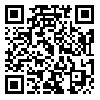Volume 6, Issue 2 (April 2020)
Journal of Research in Applied and Basic Medical Sciences 2020, 6(2): 115-122 |
Back to browse issues page
Download citation:
BibTeX | RIS | EndNote | Medlars | ProCite | Reference Manager | RefWorks
Send citation to:



BibTeX | RIS | EndNote | Medlars | ProCite | Reference Manager | RefWorks
Send citation to:
Babaei S, Alizadeh L. Relationship between cognitive emotion regulation strategies and body image with eating disorder symptoms in secondary school students. Journal of Research in Applied and Basic Medical Sciences 2020; 6 (2) :115-122
URL: http://ijrabms.umsu.ac.ir/article-1-107-en.html
URL: http://ijrabms.umsu.ac.ir/article-1-107-en.html
Assistant professor, Department of Sports Sciences, Faculty of Humanities, University of Maragheh, Maragheh, Iran , so_babaei@yahoo.com
Abstract: (5771 Views)
Currently, eating disorders is a concern of the World Health Organization. Because these disorders have highest mortality rate among mental illnesses devotes itself. Accordingly, the present study aims to determine the prevalence of eating disorders in high school students. The relationship between these disorders and cognitive emotion regulation and body image, which is known as a variable in social psychology. The study was a descriptive research study -correlation and three scores, Body image questionnaire (MBSRQ), eating disorders and cognitive emotion regulation has been used to collect data. Statistical population includes 300 female high school students who were selected as samples. The results showed that cognitive emotion regulation and body image and its dimensions have a significant relationship with eating disorders and dimensions between eating disorder symptoms and significant positive correlation with blaming others. In other words, variable the blame to others is the ability to predict eating disorder symptoms among female students as well. There is a significant negative correlation between satisfaction of eating disorder symptoms and evaluate the fit of the body. In other words, the increase in satisfaction with areas of the body and assess the appropriateness of the symptoms of eating disorders is reduced.
Type of Study: orginal article |
Subject:
General
References
1. Lauren, Muhlheim. Articles for FEAST: Addressing Eating Disorders in Middle and High Schools, Retrieved November 13, 2013, from http://feasted
2. Klein DA, Walsh BT. Eating disorders: clinical features and pathophysiology. Physiol Behav 2004: 81(2): 359-74. [DOI:10.1016/j.physbeh.2004.02.009] [PMID]
3. Yeager KK, Agostini R, Nattiv A, Drinkwater B. The female athlete triad: Disordered eating, amenorrhea, and osteoporosis. Med Sci SportsExercise 1993: 25, 775-7. [DOI:10.1249/00005768-199307000-00003] [PMID]
4. Yannakoulia M, Matalas AL, Yiannakouris N, Papoutsakis C, Passos M, Klimis-Zacas D. Disordered eating attitudes: an emerging health problem among Mediterranean adolescents. Eat Weight Disord 2004:9(2):126-33. [DOI:10.1007/BF03325056] [PMID]
5. Becker, Anne E. Eating disorders classification. Int J Eat Disorders 2007: 40 (4): 111-6. [DOI:10.1002/eat.20435] [PMID]
6. Wood K. Effects of a media intervention program on the body image and eating attitude among children. J Undergrad Res. 2004:6 (3):1-6. [Google Scholar]
7. Rosen JC, Silberg NT, Gross J. Eating attitudes test and eating disordeas inventory: norms for adolescent girls and boy. J Consult Clin Psychol 1988:56, 2:305-8. [DOI:10.1037/0022-006X.56.2.305] [PMID]
8. Cooper MJ, Whelan E, Morrell J, Murray L. Association between childhood feeding problems and maternal eating disorder: role of the family environment. Br J Psychiatry 1994:184:210-5. [DOI:10.1192/bjp.184.3.210] [PMID]
9. Cialdini R. B, Darby, B. LVincent, J. E. Transgression and altruism: Ahedonism. Journal of Experimental Social Psychology, 9, 502-516. Concerns. Behav Therapy 1973: 27, 25-39. [DOI:10.1016/0022-1031(73)90031-0]
10. Stice E, Shaw H. Eating disorder prevention programs: A meta-analytic review. Psychol Bull 2004:130, 206-27. [DOI:10.1037/0033-2909.130.2.206] [PMID]
11. Wichianson JR, Bughi SA, Unger JB. Perceived stress, Coping and night- eating in college students. Institute for Health Promotion and Disease prevention Research, University of Southern California Keck school of Medicine, Los Angeles, CA, USA. 2008. [Wiley]
12. Berry DS, Pennebaker JW. Nonverbal and verbal emotional expression and health. Psychother Psychosom 1993:59, ll-9. [DOI:10.1159/000288640] [PMID]
13. Ochsner KN, Gross JJ. The cognitive control of emotion. Trends in Cognitive Sciences 2005: 9, 242-9. [DOI:10.1016/j.tics.2005.03.010] [PMID]
14. Gilboa E, Avnon L, Zubery E, Jeczmien P. Emotional processing in eating disorders: specific impairment or general distress related deficiency? J Depression Anxiety 2006: 23(6), 331-9. [DOI:10.1002/da.20163] [PMID]
15. 15 Garnefski N, Kraaij V, Spinhoven P. Negative life events, cognitive emotion regulation, and emotional problems. Pers Individ Dif 2001: 30 (8): 1311-27. [DOI:10.1016/S0191-8869(00)00113-6]
16. Nobakht M, Dezhkam M. An epidemiological study of eating disorders in Iran. Int J Eat Disord 2000: 28 (3):265-71.
https://doi.org/10.1002/1098-108X(200011)28:3<265::AID-EAT3>3.0.CO;2-L [DOI:10.1002/1098-108X(200011)28:33.0.CO;2-L]
17. Koifman R. The relation between Eating Pathology and Emotional Intelligence in university women, The University of Wincisor, Submitted to the College of Graduate Studies and Research Through the Department of Psychology in Patial Fulfillment of the Requirements for the Degree of Arts at the University of W incisor, Windsor, Ontario, Canada. 1999. [Google Scholar]
18. Mckenzi T. Parental correlate, of disordered eating among college women. (Dissertation). Human Development. 2008.
19. Czaja J, Rief W, Hilbert Anja. Emotion regulation and eating in children. Int J Eat Disorder 2009:42(4), 356- 62. [DOI:10.1002/eat.20630] [PMID]
20. Pirrehumbert B, Bader M, Miljkoviteh R. Strategies of emotion regulation in adolescents and young adults with substance dependence or eating disorders. Swiss National science Foundation. 2004. [Google Scholar]
21. Eisenberg N. Emotion regulation and moral development. Annu Rev Psychol 2000; 51:665-97. [DOI:10.1146/annurev.psych.51.1.665] [PMID]
22. Paxton SJ, Wertheim EH, Gibbons K, Szmukler GI, Hillier L, Petrovich JL. Body image satisfaction, dieting beliefs, and weight loss behaviors in adolescent girls and boys. J Youth Adolescence 1991:20, 361-79. [DOI:10.1007/BF01537402] [PMID]
23. Levine MP, Smolak L, Hayden H. The relation of sociocultural factors to eating attitudes and behaviors among middle school girls. J Early Adolesc 1994:14, 471-90. [DOI:10.1177/0272431694014004004]
24. Striegel-Moore RH, Schreiber GB, Pike KM, Wilfley DE, Rodin J. Drive for thinness in Black and White preadolescent girls. Int J Eat Disorders 1995: 18, 59-69.
https://doi.org/10.1002/1098-108X(199507)18:1<59::AID-EAT2260180107>3.0.CO;2-6 [DOI:10.1002/1098-108X(199507)18:13.0.CO;2-6]
Send email to the article author
| Rights and permissions | |
 |
This work is licensed under a Creative Commons Attribution-NonCommercial 4.0 International License. |






 gmail.com
gmail.com